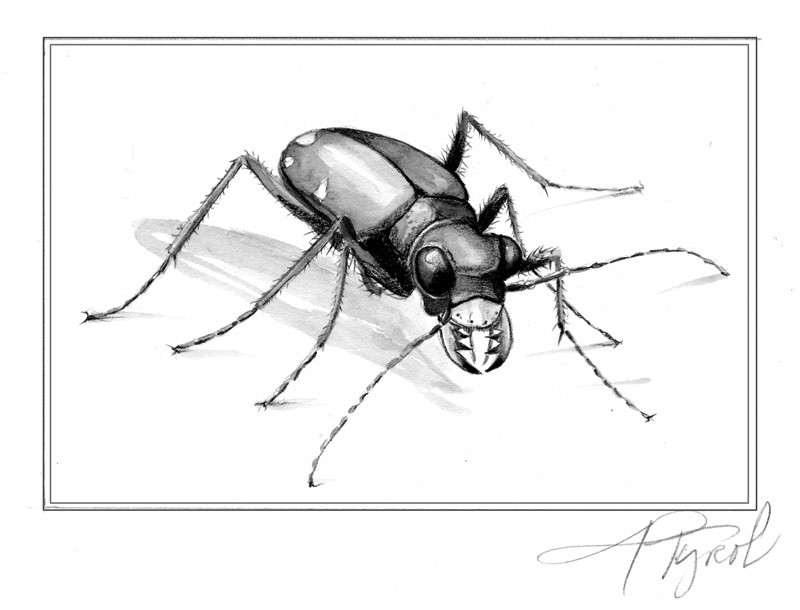
On a meadow walk the other day, near my home in St. Johnsbury, Vt., I noticed a bright green insect dart along the path as I approached, then rocket into flight and disappear. It was a tiger beetle of near metallic brilliance.
I startled the insect, but just as likely, it had been planning to take off anyway, on one of its hunting trips.
Rather than lying in wait for prey like real tigers, these insect tigers range far afield in rapid, frenetic airborne searches for victims. In Vermont and New Hampshire, where more than a dozen species exist (1,400 species worldwide), one encounters them not in deep woods but in sparsely vegetated fields, rocky outcrops, or sandy areas near rivers and streams. They are most active when the temperature outside is at 60 degrees F. or warmer, so look for them while hiking on hot summer afternoons.
Tiger beetles, in both adult and larval stages, have a body design that places them among the world’s most efficient predators.
Despite differences in coloration, habitat and size, all tiger beetle species share traits and life cycles. The long-lasting success of their basic design is confirmed by fossil evidence that they roamed the pre-human world some 45 million years ago.
A tiger beetle is keenly attuned to its natural surroundings. Big, bulging compound eyes provide acute vision within six-inches; and any movement within that range, on land or in air, is investigated immediately. With sensors in its feet, a tiger beetle detects the slightest ground vibration. The beetle’s streamlined body is elevated on long slender legs that move in a blur as it dashes along the ground either to capture prey or to get a good start before lift-off.
Few insects can out-maneuver this predator; even fewer can escape its great scimitar jaws once they clamp shut for the kill. These curved jaws are so large that they cross over one another when the beetle is at rest.
To inspect a tiger beetle one must capture it (very difficult) or follow it in the field with powerful close-focusing binoculars. It’s almost impossible to simply walk up to one and observe.
If your eyes are sharp and you lower yourself to ground level, however, you might at least glimpse them in their no-less-impressive larval stage. Check in fields for their homes—clean holes, about the diameter of a pencil, or smaller, that lack the characteristic piles of excavated soil marking digger wasp or ant activity. The holes may occur in clusters of a dozen or more in only a square foot.
If you approach quietly – so it doesn’t quickly hunch deep underground—you’ll find a burrow that is plugged with what appears to be a tiny, iridescent manhole cover lying flush with the soil. This plate is the larva’s disk-shaped head that serves to obscure both the burrow and the rest of the occupant’s body. The flat exposed top of the head generally is bumpy and covered with bristles. Two six-pack clusters of tiny black eyes look out; and even though they don’t in any way resemble the huge compound eyes of the adult tiger beetle, they perceive crude visual patterns and detect movement up to three inches away. A pair of long, curved jaws lies flat and open, ready to seize any hapless ant, beetle, locust, caterpillar, or spider that happens to stroll by.
Removed from its burrow, a tiger beetle larva looks like a slender, humpbacked grub with six short legs at the front of its body and two sharp hooks on a large bump halfway down its back. These hooks serve as braces to prevent the larva from being pulled from its burrow by a too-active victim, or by a larger predator.
Once prey is caught, the larva quickly drops from the surface, leaving only an open hole in the soil. In the darkness below, the insect’s curved jaws inject a paralyzing, digesting enzyme that quickly dissolves tissues so nourishing fluids, including the dissolved tissues, can be sucked from the shriveling victim.
Because tiger beetles, whether larval or adult, are so quick to hide or depart from our presence, we are hardly aware of their existence or commonness. Not knowing them, we don’t appreciate their value to humans as they consume vast numbers of noisome flies and mosquitoes and crop-consuming caterpillars.

